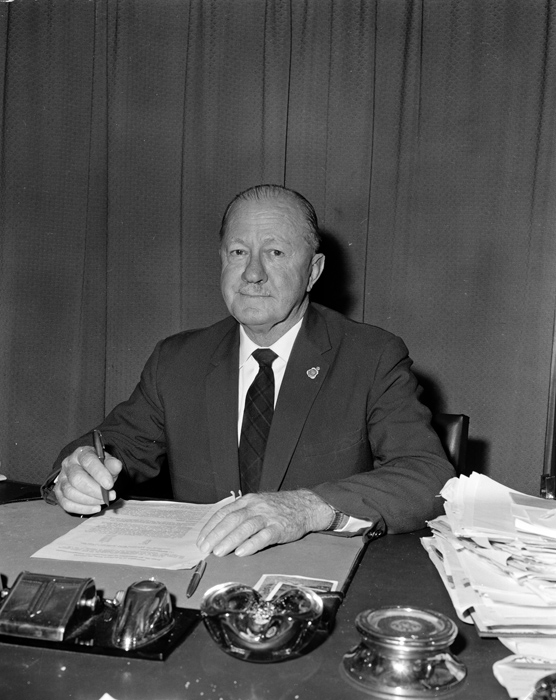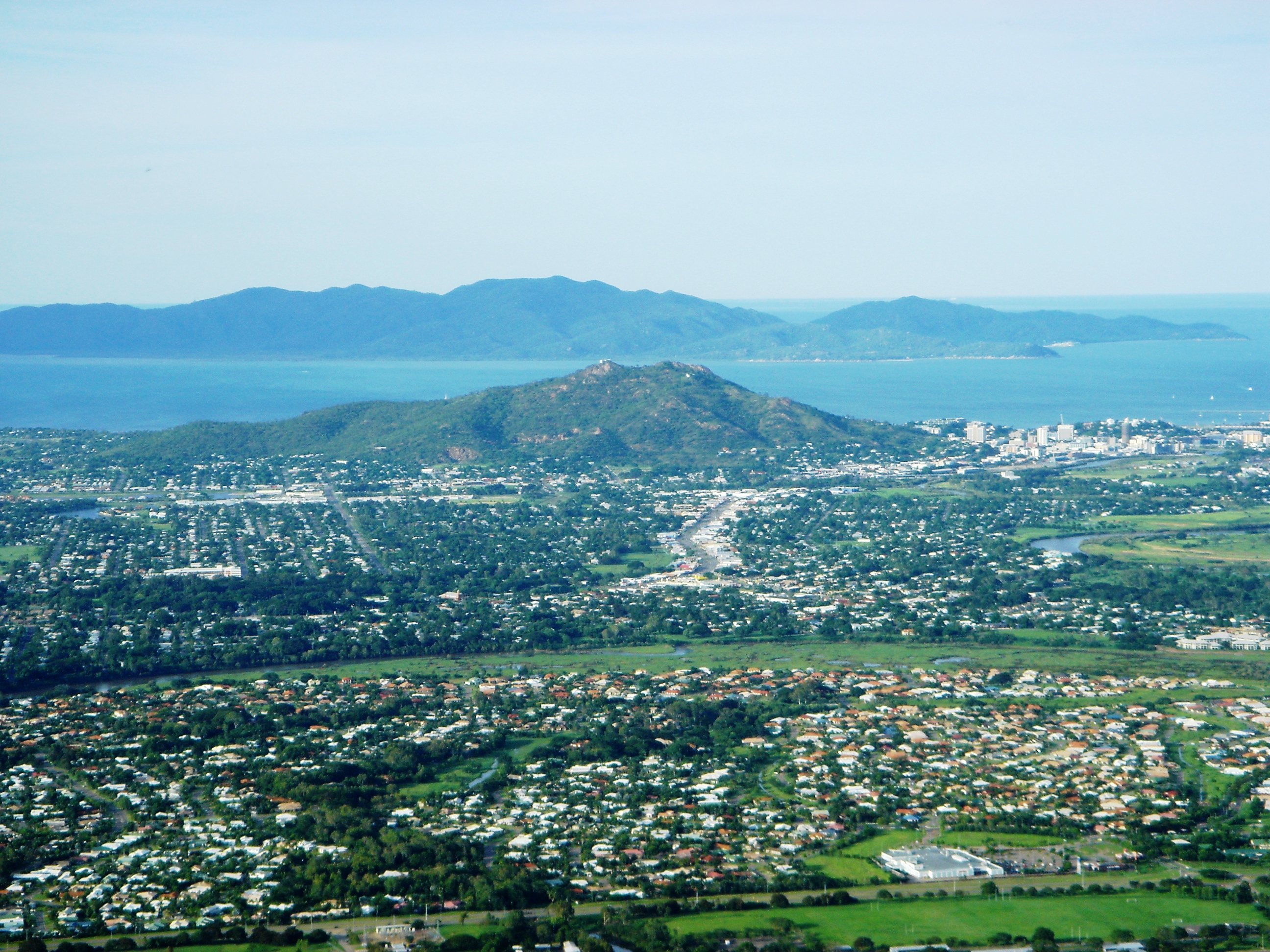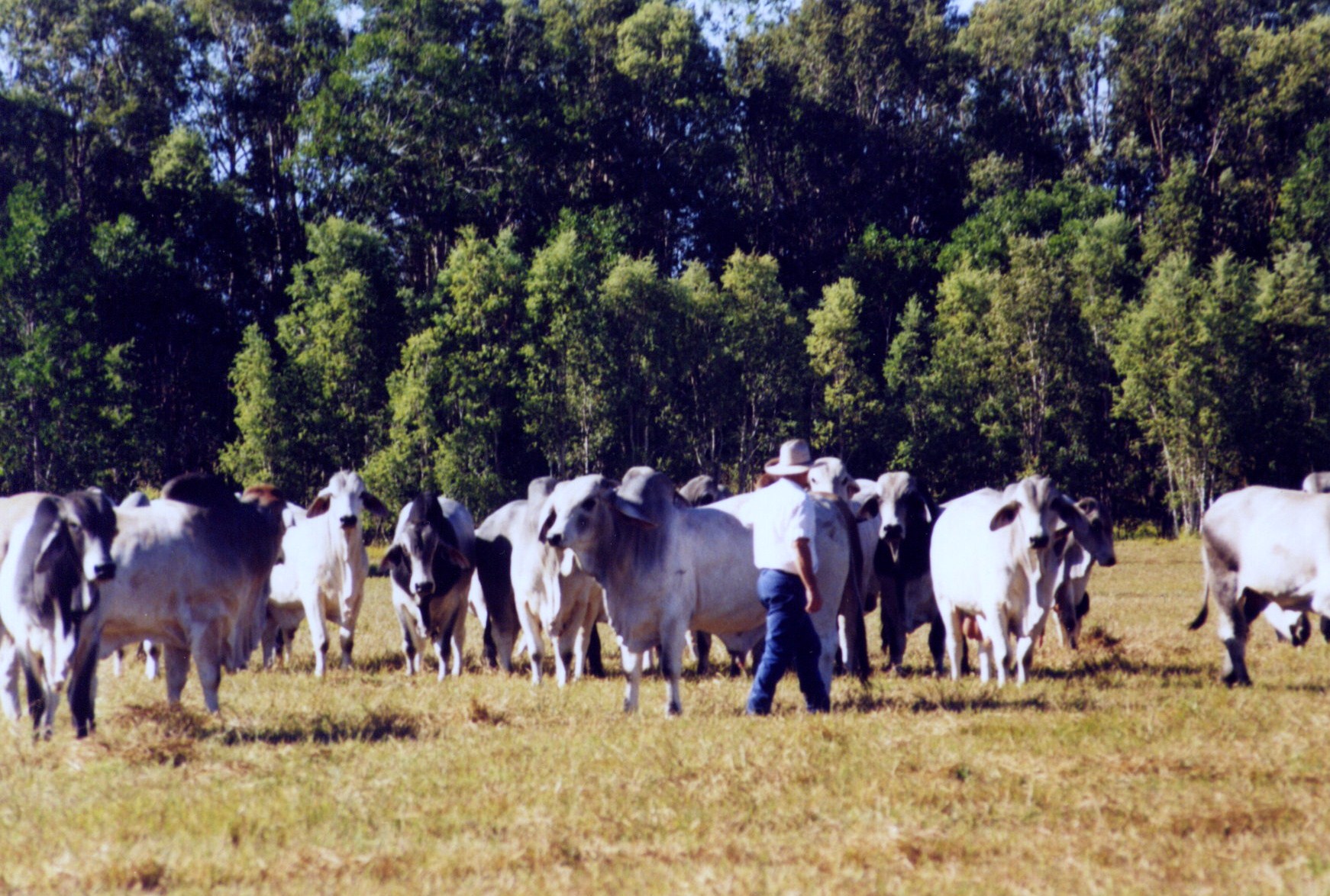|
Sir Charles William Davidson
Sir Charles William Davidson KBE (14 September 1897 – 29 November 1985) was an Australian politician. He was deputy leader of the Country Party from 1956 to 1963 and represented the party in federal parliament from 1946 to 1963. He served as Postmaster-General of Australia (1956–1963) and Minister for the Navy (1956–1958) in the Menzies Government. Early life Davidson was born on 14 September 1897 in Toowong, Queensland. He was the third child of Marion (née Perry) and Alexander Black Davidson. His mother born in England and his father in Scotland. Davidson attended Townsville Grammar School until 1914 and then found work as a stockman in North Queensland. He enlisted in the Australian Imperial Force in February 1916 and served on the Western Front with the 42nd Battalion. He was wounded in action in September 1918 and returned to Australia. Military service He served in World War I. During World War II, he served in the 42nd Battalion of the Australian Army in ... [...More Info...] [...Related Items...] OR: [Wikipedia] [Google] [Baidu] |
The Honourable
''The Honourable'' (British English) or ''The Honorable'' (American English; see spelling differences) (abbreviation: ''Hon.'', ''Hon'ble'', or variations) is an honorific style that is used as a prefix before the names or titles of certain people, usually with official governmental or diplomatic positions. Use by governments International diplomacy In international diplomatic relations, representatives of foreign states are often styled as ''The Honourable''. Deputy chiefs of mission, , consuls-general and consuls are always given the style. All heads of consular posts, whether they are honorary or career postholders, are accorded the style according to the State Department of the United States. However, the style ''Excellency'' instead of ''The Honourable'' is used for ambassadors and high commissioners. Africa The Congo In the Democratic Republic of the Congo, the prefix 'Honourable' or 'Hon.' is used for members of both chambers of the Parliament of the Democratic Repu ... [...More Info...] [...Related Items...] OR: [Wikipedia] [Google] [Baidu] |
Toowong, Queensland
Toowong is a riverside suburb in the City of Brisbane, Queensland, Australia. In the , Toowong had a population of 10,830 people. Geography Toowong is situated between Mount Coot-tha and the Brisbane River and is made up of rolling hills with little flat land. Since European settlement most of the land has been cleared for residential and commercial use with the exception of some park land and bushland near the Western Freeway. At the centre of Toowong is a commercial precinct including Toowong Village, and several other commercial and office buildings. The western side of the suburb is predominantly residential with a mix of medium density dwellings and detached Queenslander houses, extending to the foothills of Mount Coot-tha. Toowong borders the Brisbane River. Along the riverside are a number of transport links: Coronation Drive, the Regatta ferry wharf, and the Bicentennial Bike Path (a bike and walkway) to the Brisbane CBD. This section of the river is the Toowong ... [...More Info...] [...Related Items...] OR: [Wikipedia] [Google] [Baidu] |
Australian Government
The Australian Government, also known as the Commonwealth Government, is the national government of Australia, a federal parliamentary constitutional monarchy. Like other Westminster-style systems of government, the Australian Government is made up of three branches: the executive (the prime minister, the ministers, and government departments), the legislative (the Parliament of Australia), and the judicial. The legislative branch, the federal Parliament, is made up of two chambers: the House of Representatives (lower house) and Senate (upper house). The House of Representatives has 151 members, each representing an individual electoral district of about 165,000 people. The Senate has 76 members: twelve from each of the six states and two each from Australia's internal territories, the Australian Capital Territory and Northern Territory. The Australian monarch, currently King Charles III, is represented by the governor-general. The Australian Government in its executive ca ... [...More Info...] [...Related Items...] OR: [Wikipedia] [Google] [Baidu] |
Parliament Of Australia
The Parliament of Australia (officially the Federal Parliament, also called the Commonwealth Parliament) is the legislature, legislative branch of the government of Australia. It consists of three elements: the monarch (represented by the Governor-General of Australia, governor-general), the Australian Senate, Senate and the Australian House of Representatives, House of Representatives.Constitution of Australia, Section 1 of the Constitution of Australia, section 1. The combination of two elected chambers, in which the members of the Senate represent the States and territories of Australia, states and territories while the members of the House represent electoral divisions according to population, is modelled on the United States Congress. Through both chambers, however, there is a Fusion of powers, fused executive, drawn from the Westminster system.. The upper house, the Senate, consists of 76 members: twelve for each state, and two each for the territories, Northern Terr ... [...More Info...] [...Related Items...] OR: [Wikipedia] [Google] [Baidu] |
Hansard
''Hansard'' is the traditional name of the transcripts of parliamentary debates in Britain and many Commonwealth countries. It is named after Thomas Curson Hansard (1776–1833), a London printer and publisher, who was the first official printer to the Parliament at Westminster. Origins Though the history of the ''Hansard'' began in the British parliament, each of Britain's colonies developed a separate and distinctive history. Before 1771, the British Parliament had long been a highly secretive body. The official record of the actions of the House was publicly available but there was no record of the debates. The publication of remarks made in the House became a breach of parliamentary privilege, punishable by the two Houses of Parliament. As the populace became interested in parliamentary debates, more independent newspapers began publishing unofficial accounts of them. The many penalties implemented by the government, including fines, dismissal, imprisonment, and investigati ... [...More Info...] [...Related Items...] OR: [Wikipedia] [Google] [Baidu] |
New Guinea Campaign
The New Guinea campaign of the Pacific War lasted from January 1942 until the end of the war in August 1945. During the initial phase in early 1942, the Empire of Japan invaded the Australian-administered Mandated Territory of New Guinea (23 January) and the Australian Territory of Papua (21 July) and overran western New Guinea (beginning 29/30 March), which was a part of the Netherlands East Indies. During the second phase, lasting from late 1942 until the Japanese surrender, the Allies—consisting primarily of Australian forces—cleared the Japanese first from Papua, then the Mandate and finally from the Dutch colony. The campaign resulted in a crushing defeat and heavy losses for the Empire of Japan. As in most Pacific War campaigns, disease and starvation claimed more Japanese lives than enemy action. Most Japanese troops never even came into contact with Allied forces, and were instead simply cut off and subjected to an effective blockade by Allied naval forces. Garrison ... [...More Info...] [...Related Items...] OR: [Wikipedia] [Google] [Baidu] |
Australian Army
The Australian Army is the principal Army, land warfare force of Australia, a part of the Australian Defence Force (ADF) along with the Royal Australian Navy and the Royal Australian Air Force. The Army is commanded by the Chief of Army (Australia), Chief of Army (CA), who is subordinate to the Chief of the Defence Force (Australia), Chief of the Defence Force (CDF) who commands the ADF. The CA is also directly responsible to the Minister of Defence (Australia), Minister for Defence, with the Department of Defence (Australia), Department of Defence administering the ADF and the Army. Formed in 1901, as the Commonwealth Military Forces, through the amalgamation of the colonial forces of Australia following the Federation of Australia. Although Australian soldiers have been involved in a number of minor and major conflicts throughout Australia's history, only during the Second World War has Australian territory come under direct attack. The Australian Army was initially composed a ... [...More Info...] [...Related Items...] OR: [Wikipedia] [Google] [Baidu] |
Australian Dictionary Of Biography
The ''Australian Dictionary of Biography'' (ADB or AuDB) is a national co-operative enterprise founded and maintained by the Australian National University (ANU) to produce authoritative biographical articles on eminent people in Australia's history. Initially published in a series of twelve hard-copy volumes between 1966 and 2005, the dictionary has been published online since 2006 by the National Centre of Biography at ANU, which has also published ''Obituaries Australia'' (OA) since 2010. History The ADB project has been operating since 1957. Staff are located at the National Centre of Biography in the History Department of the Research School of Social Sciences at the Australian National University. Since its inception, 4,000 authors have contributed to the ADB and its published volumes contain 9,800 scholarly articles on 12,000 individuals. 210 of these are of Indigenous Australians, which has been explained by Bill Stanner's "cult of forgetfulness" theory around the co ... [...More Info...] [...Related Items...] OR: [Wikipedia] [Google] [Baidu] |
42nd Battalion (Australia)
The 42nd Battalion was an infantry battalion of the Australian Army. Raised as part of the Australian Imperial Force (AIF) during the First World War, it was established at Enoggera in December 1915, forming part of the 11th Brigade in the 3rd Division. It subsequently served on the Western Front in France and Belgium in 1916–18 before being disbanded on 22 October 1918. In 1921, the battalion was reformed as part of the Citizens Forces becoming known as the 42nd Battalion (Capricornia Regiment). Following the outbreak of the Second World War the battalion held a number of training exercises and camps until 1941, before being mobilised in March 1942 as part of the 29th Brigade, in the 5th Division. It subsequently served in New Guinea fighting against the Japanese during 1943–44 and on Bougainville in 1945, before being disbanded on 7 May 1946. In 1948, it was reformed as part of the re-raised Citizens Military Forces. Today, its lineage is perpetuated by the 31st/42 ... [...More Info...] [...Related Items...] OR: [Wikipedia] [Google] [Baidu] |
First Australian Imperial Force
The First Australian Imperial Force (1st AIF) was the main expeditionary force of the Australian Army during the First World War. It was formed as the Australian Imperial Force (AIF) following Britain's declaration of war on Germany on 15 August 1914, with an initial strength of one infantry division and one light horse brigade. The infantry division subsequently fought at Gallipoli between April and December 1915, with a newly raised second division, as well as three light horse brigades, reinforcing the committed units. After being evacuated to Egypt, the AIF was expanded to five infantry divisions, which were committed to the fighting in France and Belgium along the Western Front in March 1916. A sixth infantry division was partially raised in 1917 in the United Kingdom, but was broken up and used as reinforcements following heavy casualties on the Western Front. Meanwhile, two mounted divisions remained in the Middle East to fight against Turkish forces in the Sinai an ... [...More Info...] [...Related Items...] OR: [Wikipedia] [Google] [Baidu] |
North Queensland
North Queensland or the Northern Region is the northern part of the Australian state of Queensland that lies just south of Far North Queensland. Queensland is a massive state, larger than many countries, and its tropical northern part has been historically remote and undeveloped, resulting in a distinctive regional character and identity. Townsville is the largest urban centre in North Queensland, leading it to be regarded as an unofficial capital. The region has a population of 231,628 and covers . Geography There is no official boundary that separates North Queensland from the rest of the state. Unofficially it is usually considered to have a southern border beginning south of the Mackay Region southern boundary, but historically it has been as far south as Rockhampton. To the north is the Far North Queensland region, centred on Cairns and out west is the Gulf Country. A coastal region centred on its largest settlement is the city of Townsville. The city is the locatio ... [...More Info...] [...Related Items...] OR: [Wikipedia] [Google] [Baidu] |
Stockman (Australia)
In Australia a stockman (plural stockmen) is a person who looks after the livestock on a large property known as a station (Australian agriculture), station, which is owned by a wikt:grazier, grazier or a grazing company, traditionally on horseback. In this sense it has a similar meaning to "cowboy". A stockman may also be employed at an abattoir, feedlot, on a livestock export ship, or with a stock and station agency. Associated terms Stockmen who work with the cattle in the Top End are known as ringers and are often only employed for the dry season which lasts from April to October. A station hand is an employee who is involved in routine duties on a rural property or station, which may also involve caring for livestock. With pastoral properties facing dire recruitment problems as young men are lured into the booming mining industry, young women from the cities are becoming a common sight on outback stations, often attracted by the chance to work with horses. An associated ... [...More Info...] [...Related Items...] OR: [Wikipedia] [Google] [Baidu] |




.jpg)



